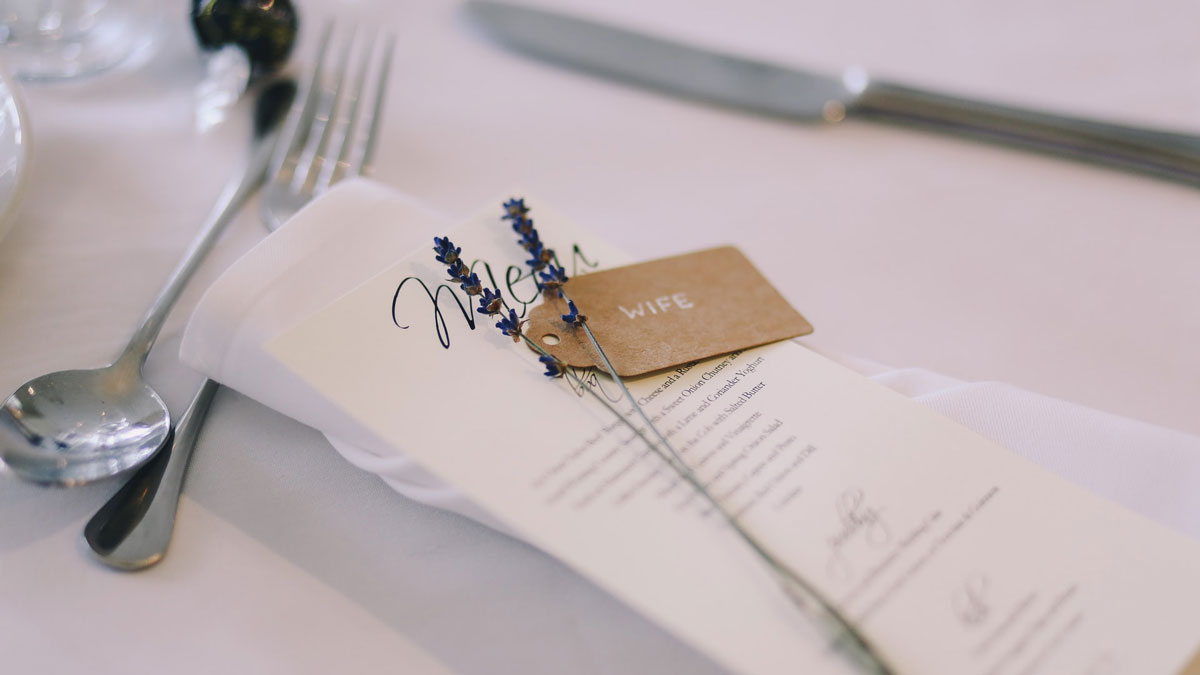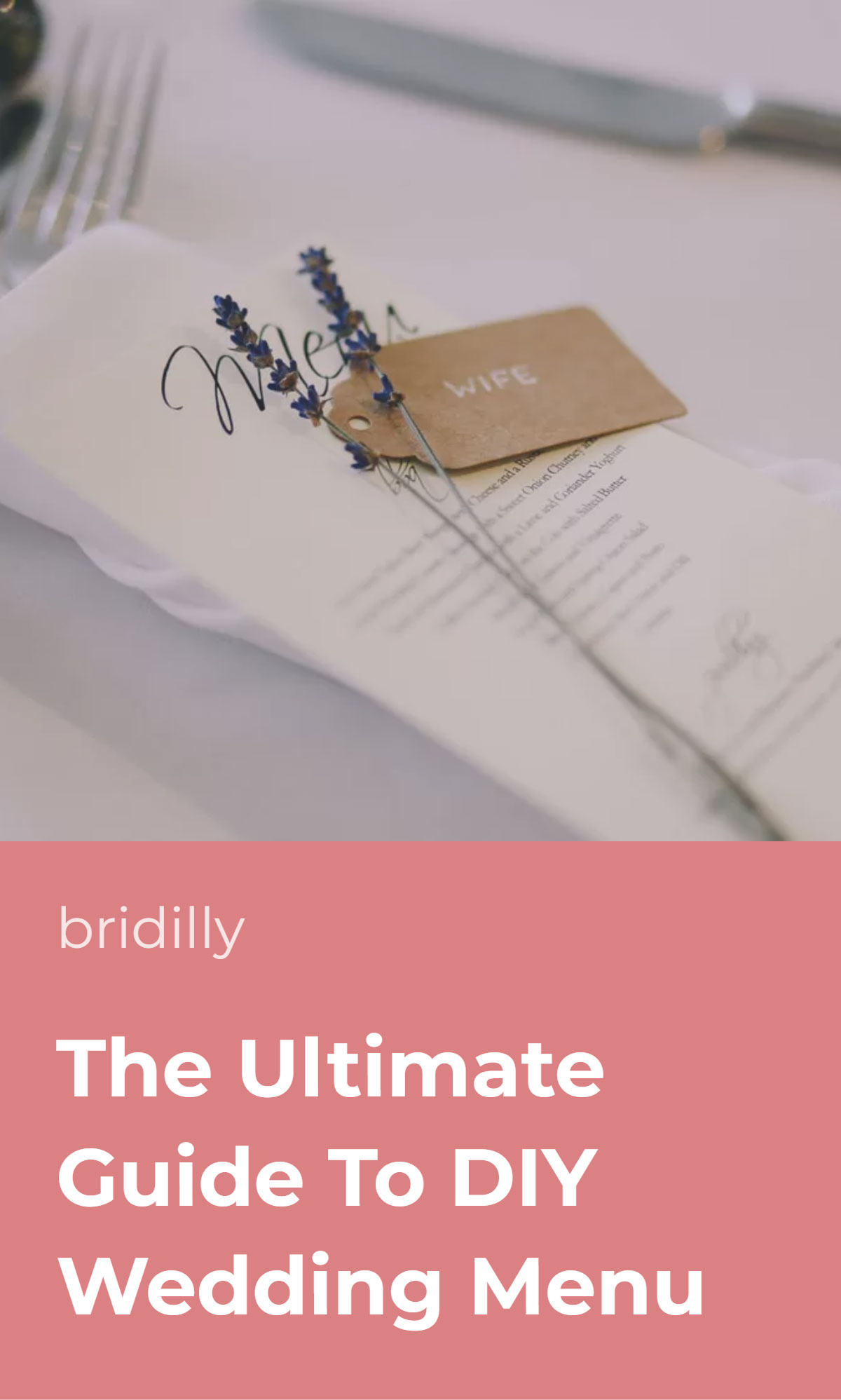Planning a wedding menu isn’t a simple task, let alone a DIY wedding menu. The variety of recipes and points to consider can be overwhelming.
You may have imagined your dream wedding gown since childhood, but have you ever thought of your reception dinner?
While the menu isn’t the first thing most freshly engaged brides plan, the right choice of food and drinks is essential to creating your wedding atmosphere.
Your wedding menu should be appropriate for the location, event theme, season and match your preferences. Furthermore, you should accommodate your guests’ dietary restrictions.
Although planning your wedding menu is stressful, it isn’t impossible if you know how to do it right. You may even cook the meals yourself if you don’t have the budget for a catered reception.
Table of Contents [show]
Consider the Season
While you’re free to choose any food any prefer for your wedding reception, incorporating seasonal recipes is always a good idea. This will help you pull together the wedding theme and ensure that the food is fresh and flavored.
Seasonal wedding menus differ by flavor combinations and colors. Spring and summer wedding menus typically consist of vegetables, fruits, and herbs and are decorated in pastel or bright hues with lots of flowers.
Overall, spring and summer menus are refreshing and juicy. The best summer wedding recipe ideas include shrimp gazpacho, spring rolls, vegetable risotto, and miniature crab cakes.
As for the drinks, sweet cocktails such as mai tai and pina colada or classic champagne are perfect choices.
Summer wedding cakes are traditionally light and not overly sweet – for instance, with lavender or peach-yogurt flavors.
Fall and winter wedding menus tend to be more indulgent and savory, usually in darker, richer colors.
You may serve bacon-wrapped dates or cranberry and brie bites as appetizers, roasted pork or grilled chicken as main courses, and caramelized apples for dessert.
Some great winter wedding drink ideas are mulled wine, hot apple cider, and Irish coffee. Pair them with decadent triple-chocolate, carrot, or red velvet cakes.
Location Matters
Apart from the season, you should consider the wedding location and overall style. An oyster bar isn’t a great match for a rustic wedding in a barn, and burgers don’t fit a glamorous wedding in a castle.
Think about what atmosphere you want to create and tie the venue and menu together.
If you host the wedding reception on a beach, choose tropical or marine foods, and if your wedding is in an industrial-style venue, consider unusual recipes with a twist.
Set the Budget
Budget is one of the key considerations in planning your wedding menu. The cost of food per person can fluctuate drastically depending on the food and reception type, your location, season, and other factors.
The average price of wedding catering per guest in the U.S. is about $40, while buffet receptions are significantly cheaper – about $26 per person.
Note that these rates don’t include any alcohol – the starting price for wedding bar service in the U.S. is about $14 per guest.
The cost can skyrocket if you serve signature cocktails but may be lower if you only serve beer and wine without a bartender.
Self-catering usually isn’t much cheaper than a catered buffet reception. The thing is, most professional caterers can buy groceries in bulk and include the tableware and delivery in the price.
And if you cater the reception yourself, you will likely have to buy groceries in your local supermarket for the regular price and deliver it to the venue on your own.
The budget should serve as the starting point in your wedding menu planning, along with the season and location.
There are cheap and luxurious recipes for any wedding theme; all you need is a bit of research and creativity.
Buffet vs Plated Dinner
One of the first points to consider when planning your wedding menu is whether you prefer to serve a plated dinner or a buffet reception. Each option has its benefits and drawbacks.
Buffet receptions are more laid-back, as guests serve food themselves.
Buffet stations offer a great option variety, and everyone can eat as much as they wish. Furthermore, you can dedicate each station to a specific food type.
Buffets also tend to be cheaper, though this largely depends on the type of food served. On the other hand, some people frown upon such a casual format and even consider wedding buffets tacky.
Plated dinner is the most formal wedding reception type where guests don’t serve the food themselves. You have more control over the overall food amount and don’t have to offer as many options, which is great.
However, plated dinners also are more expensive on average, and planning a streamlined plated wedding dinner requires more effort.
Both options are suitable for a self-catered wedding, but buffets are a bit easier. If you want to serve an individual hot dinner for each guest simultaneously, you will need a lot of help and multiple ovens.
Trends aren’t mandatory for consideration but can be helpful in DIY wedding menu planning.
Learning about the hottest wedding menu trends can inspire you and ensure your event isn’t old-fashioned – unless that’s what you want to achieve.
In fact, nostalgic treats have been exceedingly popular in recent years. People like to indulge in childhood memories, and nothing evokes them better than grandma’s apple pie or chicken with mac and cheese.
Local ingredients have also been on the surge recently, and it’s no wonder – local-grown foods tend to be fresher, more flavored, and cheaper. Furthermore, such a menu supports local businesses and is environmentally friendly.
Vegetarian and vegan menus are in high demand as more and more people are changing their diets. Even if you aren’t vegan, chances are, some of your guests are, so consider incorporating a couple of meatless dishes into your menu.
Signature cocktails don’t necessarily have to be alcoholic – consider serving so-called mocktails, a healthy alternative made with fresh juices, herbs, spices, and florals.
Accommodate Preferences & Allergies
Your wedding day is all about you, and only you are to decide what’s on your wedding menu. However, you shouldn’t neglect your guests’ allergies and dietary restrictions – that’s basic wedding etiquette.
Ask your guests about the foods they can’t eat before planning your DIY wedding menu and incorporate some dishes to accommodate them. For instance, you may serve two main course options – one with meat and one vegetarian.
If you want to serve each guest an individual plated dinner, make sure that everyone gets the correct meal.
And if you’re planning a buffet reception, avoid allergens in all meals, as your guests likely won’t ask you about peanut content in every dish.
Choose a Theme
A perfect menu consists of a good mix of options, from savory and indulgent to light and refreshing.
You may include vegetarian and meat dishes, spicy and sweet, but all the foods must be tied with one concept to support the overall wedding theme.
Food is an essential element of the atmosphere. You’d likely expect something homey and comforting from a rustic wedding and something exquisite from an Art Deco-themed reception.
For instance, roasted chicken with herbs, pulled pork with gravy, and sweet potato pie are a perfect fit for a Southern-style wedding, and a fresh salad bar with local ingredients is an excellent choice for an eco-friendly wedding.
Simple Recipes for Self-Catered Reception
If you don’t have the budget for professional wedding catering, you may cook the food yourself. But in this case, you will need to adjust the menu accordingly.
Evaluate your cooking skills adequately and choose simple recipes to ensure nothing goes wrong.
Barbeque works great for outdoor receptions – you can quickly cook multiple portions at once. Mini versions of popular foods, such as burgers and sandwiches, make great appetizers and don’t require extensive cooking.
You may even let the guests assemble their meals themselves – for instance, serve a taco buffet with different toppings and sides. Salads are another simple and tasty self-catered wedding menu option.
As for drinks, the easiest option is to serve unlimited beer and wine on the tables rather than ask your uncle to work as a bartender. Don’t forget to offer multiple non-alcoholic options, too.
Avoid foods you aren’t experienced in cooking or those requiring long oven time and strive to prepare as much in advance as possible. It’s great if you can get someone to help you cook and serve the food, too.
The Perfect Wedding Cake
Out of all wedding foods, the wedding cake gets the most attention. But how do you choose a perfect wedding cake? The first tip to remember is that you should only choose the cake after you’ve made all the major planning.
The wedding cake should match your main menu, season, and wedding theme. Don’t forget to accommodate allergies, too!
If one of your guests has an allergy to carrots, serving a carrot cake isn’t the best idea, even if it’s your favorite.
Even if you host a self-catered wedding, consider outsourcing the cake to a professional unless you have excellent baking skills. It will inevitably be in the spotlight, and you likely want it to be beautiful and tasty.
At the end of the day, you aren’t obliged to have a cake at all. Nowadays, many couples prefer a more laid-back dessert buffet option with cupcakes, cookies, fruits, cake pops, smores, or caramelized apples.













No Comments Add one
Leave a Comment